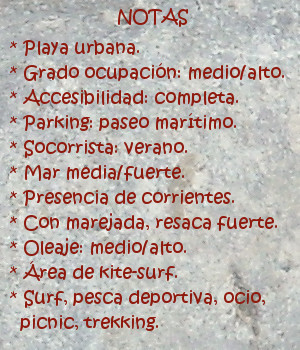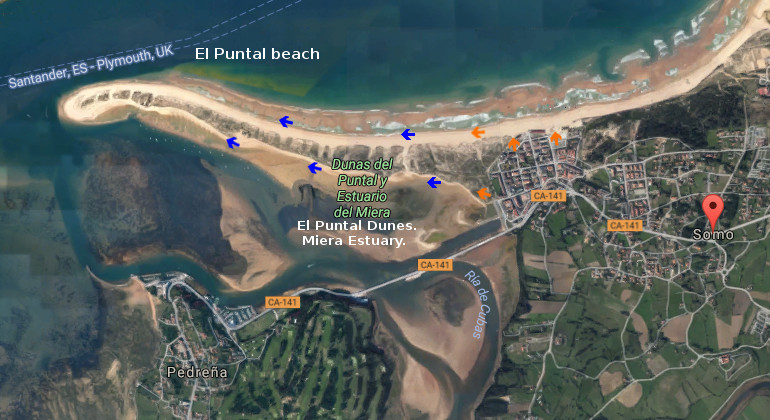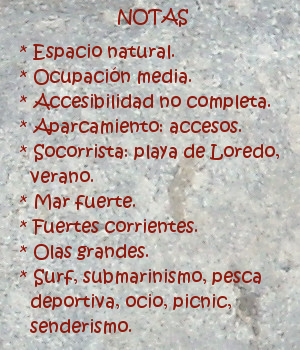 Somo es una localidad emplazada en el sur de la Bahía de Santander, que pertenece al municipio de Ribamontán al Mar. Comunicada con Pedreña por el Puente de Somo y con Loredo por carretera nacional, tiene además un servicio regular de lanchas que lo conecta con Santander.
Somo es una localidad emplazada en el sur de la Bahía de Santander, que pertenece al municipio de Ribamontán al Mar. Comunicada con Pedreña por el Puente de Somo y con Loredo por carretera nacional, tiene además un servicio regular de lanchas que lo conecta con Santander.
La playa de Somo, con una longitud de 3,5 kilómetros, es una de las playas más grandes de Cantabria. Su arenal se prolonga a través de la playa de Loredo, acotado en su extremo derecho por la Isla de Santa Marina, ocupa una basta extensión de 5 kilómetros de recorrido. En el extremo izquierdo existe un amplia área dunar, que se introduce en la centro de la bahía. Esta parte de la playa se llama El Puntal. La cara sur de esta lengua de arena y vegetación tiene una longitud de tres kilómetros, finalizando en el embarcadero de Somo. Se abre, en esta parte, una zona protegida del contacto directo con el oleaje; existiendo así un área idónea para la practica del windsurf y kitesurf.
La playa contiene varias zonas diferenciadas con distintos tipos de ola. La parte más cercana al Puntal dibuja su trazado con una ligera curva, que propicia la aparición de olas que abren a derechas; cuando las condiciones del mar son favorables. La segunda zona, conocida como El Barco, recibe su nombre por existir el casco de un barco naufragado y parcialmente hundido en el fondo de arena. Este lugar presenta corrientes cambiantes y remolinos, además del peligro que supone practicar surf en las cercanías de los restos. Tiene buenas olas, que abren a ambos lados, siendo adecuado el espacio emplazado a 100 metros por detrás del barco. El tercer punto se coloca a la derecha. Conocido como el camping, abarca una extensión mayor y por ello acoge varios tipos de ola que abren a ambos lados, según su proximidad a la zona del Barco o La Curva.
Aquí se recogen algunos datos, junto con una breve descripción de la Playa de Somo. La percepción y conocimiento de sus aguas y olas, de su fondo arenoso, del entorno verde que la acompaña, … deben ser vividos.


Somo, beach
 Somo is a locality placed in the south of the Bay of Santander, which belongs to the municipality of Ribamontán al Mar. Communicated with Pedreña through The Bridge of Somo and Loredo by national road; it also has a regular service of boats that connects it with Santander.
Somo is a locality placed in the south of the Bay of Santander, which belongs to the municipality of Ribamontán al Mar. Communicated with Pedreña through The Bridge of Somo and Loredo by national road; it also has a regular service of boats that connects it with Santander.
Somo’s beach, with a length of 3,5 kilometres, is one of the biggest beach of Cantabria. Its sandbank extends across Loredo’s beach, annotated in its right wing for the Island of Santa Marina, occupies an extension of 5 kilometres of tour. In the left wing, exists a wide dune area, which has introduced in the center of the bay. This part of the beach is called El Puntal. The south face of this language of sand and vegetation has a length of three kilometres, that finishes in Somo’s pier. There is , in this part, a zone protected from the direct contact with the surge; that creates a suitable area for the practice of windsurfing and kitesurf.
The beach contains several zones differentiated with different types of wave. The nearest part to El Puntal draws its tracing with a light curve, which propitiates the appearance of waves that open to right; when the conditions of the sea are favorable. The second zone known as El Barco, receives its name due to exists the hull of a ship wreck and partially sunk in the back of sand. This place presents changeable currents and whirlpools, besides the danger that supposes practising surf in the surroundings of the remains. It has good waves, which open to both sides, being suitable the space located to 100 meters behind the ship. The third point is placed to the right. Acquaintance as El Camping, it includes a major extension and that is the reason to receive several types of wave that they open for both sides, according to his proximity for the zone of El Barco or La Curva.
Here is gathered some information, together with a brief description of Somo’s Beach. The perception and knowledge of its waters and waves, of its sandy bottom, of the green environment that accompanies it, … must be lived.


![]() La Isla de Santa Marina está situada enfrente de la costa de Loredo. Se encuentra en la parte más oriental de su extenso arenal, donde ya finalizan las playas de Loredo y empiezan sus acantilados. Se puede llegar a Santa Marina desde Oviedo, Palencia, Santander o desde Bilbao. Ambos trayectos finalizan en la misma carretera nacional que atreviesa el municipio de Loredo. El final del trazado se prolonga más allá del punto señalizado en la guía. Girando a la izquierda, continuando hasta encontrar al final de la carretera donde aparecerá la Isla de Santa Marina.
La Isla de Santa Marina está situada enfrente de la costa de Loredo. Se encuentra en la parte más oriental de su extenso arenal, donde ya finalizan las playas de Loredo y empiezan sus acantilados. Se puede llegar a Santa Marina desde Oviedo, Palencia, Santander o desde Bilbao. Ambos trayectos finalizan en la misma carretera nacional que atreviesa el municipio de Loredo. El final del trazado se prolonga más allá del punto señalizado en la guía. Girando a la izquierda, continuando hasta encontrar al final de la carretera donde aparecerá la Isla de Santa Marina.![]() Santa Marina Island is placed opposite the Loredo coast. It is in the most oriental part of Loredo beach, where the beaches of Loredo are already finish and begin its cliffs. It is possible to come to Santa Marina Island from Oviedo, Palencia, Santander or from Bilbao. Both ways finish in the same national road that go across the municipality of Loredo. The end of the tracing extends beyond the point that is set in the guide. Turning to the left side, continuing up to finding at the end of the road where the island will appear Santa Marina Island.
Santa Marina Island is placed opposite the Loredo coast. It is in the most oriental part of Loredo beach, where the beaches of Loredo are already finish and begin its cliffs. It is possible to come to Santa Marina Island from Oviedo, Palencia, Santander or from Bilbao. Both ways finish in the same national road that go across the municipality of Loredo. The end of the tracing extends beyond the point that is set in the guide. Turning to the left side, continuing up to finding at the end of the road where the island will appear Santa Marina Island. Localización/Localization
Localización/Localization![]()























